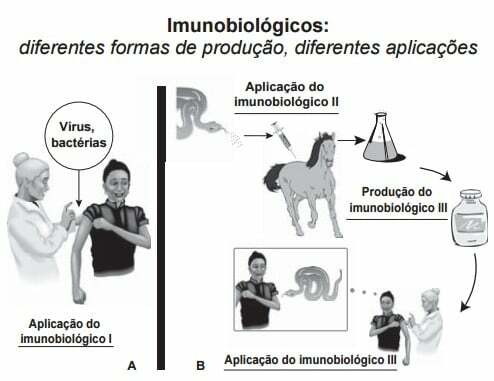The immunization process immune system takes place through the action of antigens It is antibodies which are stimulated through vaccination.
We prepared a list of exercises on antigen, antibody and vaccination so you can test your knowledge of the immune system.
see more
Ninth economy on the planet, Brazil has a minority of citizens with…
Brasilia public school keeps autistic student in 'private prison'
You can consult the feedback and save this list in PDF at the end of the post!
1) (UFF) Since the emergence of swine flu, vaccines have been developed in an attempt to establish a protection method for the population. Mark the alternative that presents the classic immunization mechanism on which vaccines are based.
a) Active immunization - mechanism, according to which a small amount of antigen is introduced into the body for antibody production.
b) Passive immunization – mechanism, according to which a large amount of antigen is introduced into the body for antibody production.
2) The first vaccine was created in the th century by Edward Jenner and guaranteed protection against smallpox. The principle used at that time is the same used today and is based on:
a) in the application of antibodies against the disease in a healthy person, guaranteeing their immunization.
b) in the application of antibodies against the disease in sick people to guarantee their cure.
c) in the application of disease-causing antigens in healthy people, ensuring their immunization.
d) in the application of disease-causing antigens to a sick person to ensure their cure.
3) (Enem) The most serious symptoms of Influenza A, caused by the H1N1 virus, were presented by older people and pregnant women. The apparent reason is the lower immunity of these groups against the virus. To increase population immunity to the influenza A virus, the Brazilian government has distributed vaccines to the most susceptible groups.
The vaccine against H1N1, like any other vaccine against agents that cause infectious diseases, increases people's immunity because:
a) has antibodies against the causative agent of the disease.
b) it has proteins that eliminate the causative agent of the disease.
c) stimulates the production of red blood cells by the bone marrow
d) it has B and T lymphocytes that neutralize the causative agent of the disease.
e) stimulates the production of antibodies against the causative agent of the disease
4) A substance composed of antibodies against a certain antigen can be called:
a) vaccine.
b) antibiotic.
c) antihistamine.
d) serum.
e) antipyretic.
5) (Enem) The human papilloma virus (HPV) causes the appearance of warts and persistent infection, being the main environmental factor of cervical cancer in women. The virus can enter through the skin or mucous membranes of the body, which develops antibodies against the threat, although in some cases the body's natural defense is not enough. A vaccine has been developed against HPV, which reduces warts by up to 90% and 85.6% of cases of persistent infection compared to unvaccinated people. Available in: http://g1.globo.com. Accessed on: 12 June. 2011.
The benefit of using this vaccine is that vaccinated people, compared to unvaccinated people, have different responses to the HPV virus due to:
a) high concentration of macrophages.
b) high rates of circulating specific anti-HPV antibodies.
c) increase in the production of red blood cells after infection with the HPV virus.
d) rapid production of high concentrations of killer lymphocytes.
e) presence of memory cells that act in the secondary response.
6) (UFJF) An individual, when bitten by a venomous snake, should be treated with antivenom, because it contains:
a) specific antibodies for snake venom toxins.
b) attenuated snake venom toxins that will induce the production of antibodies.
c) proteolytic enzymes that will destroy snake venom.
d) cells responsible for the immune response.
e) specific antigens that will inhibit the action of snake venom toxins.
7) We know that antibodies are essential to guarantee the body's defense against pathogenic organisms. These substances are produced by __________ after stimulation by an antigen and maturation of that cell.
Mark the alternative that adequately completes the space above:
a) T lymphocyte.
b) CD4 lymphocyte.
c) B lymphocytes
d) CD8 lymphocyte.
i) Eosinophils.
8) Several diseases can be prevented by means of vaccines as immunizing agents. Among the following diseases, mark the only one that still does not have a vaccine released for commercialization.
anger.
b) Rubella.
c) Flu.
d) HPV.
e) Aids.
9) After being stimulated by antigens, B lymphocytes undergo maturation and differentiate into:
a) B1 lymphocytes.
b) natural killer cell.
c) monocytes.
d) plasma cells.
i) macrophages.
10) (ENEM) Although they are produced and used in different situations, immunobiologicals I and II act similarly in humans and horses, because:

a) confer passive immunity.
b) transfer defense cells.
c) suppress the immune response.
d) stimulate the production of antibodies.
e) trigger the production of antigens.
1 — the
2 — c
3 — and
4 — d
5 — and
6 — the
7 — c
8 — and
9 — d
10 — d
Click here to save this list of exercises in PDF!
See too: